Wood sofas: characteristics, varieties and tips for choosing

Wood sofas are not an old-fashioned relic as it might seem. Their characteristics are high enough to be successful in the market even in the late 2010s. Therefore, it is very important for consumers to know the key types of such furniture and take into account the nuances of its selection.
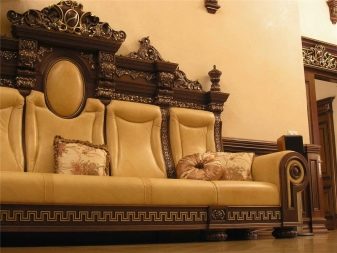

Peculiarities
A specific feature that any sofas made of wood, and even just with a base made of solid wood, have is their traditional appearance and reliability. Of course, if quality wood material is used.
Such products will perfectly fit into the most classic interior. But this is not the end of their valuable properties.


Like any other wooden furniture, the sofa will immediately create a feeling of coziness and comfort. Even where nothing else disposes to it. The surface of the array looks gorgeous - and you hardly need to apply special processing techniques to it. But you need to understand that the tree is sensitive to moisture (even if we talk about expensive tropical species). To some extent, a high mechanical strength can be considered a compensation for this deficiency.

It is also worth noting:
- environmental friendliness of wooden models;
- rather long service life;
- emphatically expensive appearance;
- the likelihood of damage by insects and rodents of various species;
- low thermal conductivity.


Views
Surprisingly, not all wooden sofas come with a backrest. In a number of models, this seemingly necessary attribute is absent. More precisely, furniture that is not equipped with armrests is much more often sold under the name of a sofa without a backrest. Therefore, you always need to check with the sellers what exactly they mean.
Equally important is how the sofa is positioned.The leg structures are nice and stable.


However, you need to understand that they sometimes scratch the floor if you move them without lifting the furniture. Wheels are less hazardous for flooring. But simple installation (without additional supports) is the worst; in this case, any movement can damage the floor, even if not applied with great force. Finally, it is worth remembering the difference between convertible and non-folding sofas.
By form
The geometric configuration of upholstered furniture is unlikely to bring any noticeable surprises. Traditionally, it is believed that a corner sofa should be placed close to the wall, and a straight line is better suited as a visual divider of the room in the middle. But if space allows, you can safely break these rules.
One has only to consult with experienced designers to rule out mistakes.
What's more interesting is that manufacturers are not limited to the most common configurations, as is often thought.


Even wood can be used to make sofas in the form of:
- whole or split circle;
- oval;
- shoes;
- motor vehicles;
- stone;
- cube and so on.

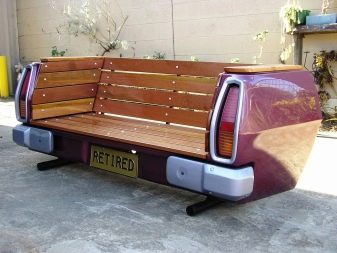
By the mechanism of transformation
Along with the usual folding sofas, there are also folding sofas. But it is much more correct to focus on the features of a particular mechanism. The guest category includes French clamshell, sedaflex and Dionysus. These mechanisms are designed to make guests more interesting while providing optimal comfort. It's a pity only one thing: this comfort is guaranteed only when landing.


After unfolding, lying on a guest-type sofa and relaxing is unlikely to work. And the transformation itself is not as simple and easy as marketers often try to convince people. But it turns out a cheap and relatively simple design. If it fails, then replacement will not be difficult.

Sofas designed for daily sleep are arranged in a completely different way. Here the level of requirements for the layout mechanism is already rising. Most often in this category they take a "book" and its improved modifications. You just need to clearly understand how the same "click-gag" differs from a simple "book". If there is an opportunity to waste time to move the sofa away from the wall every time, and such a need does not annoy people, the conclusion is quite understandable. In this case, it makes no sense to pay extra money for benefits that you will not need anyway.

The advantages of mechanisms in this category (this also includes the "dolphin", "telescope" and some others) are:
- ease of use;
- optimal rigidity;
- smooth surfaces;
- initial calculation for a large number of transformation cycles.
But even better, according to experts, roll-out sofas are suitable for sleeping.
The bottom line is that to prepare for a night's rest, you just need to roll out the sections below. Everything is very simple and therefore is extremely reliable. The problem is that rolling out quickly spoils the flooring. Even the most durable varieties of linoleum and laminate flooring will not be able to resist for a long time.

Materials (edit)
But here's a suitable mechanism for transforming a wooden sofa has been chosen. The next point in turn is what the furniture itself should be made of. Even if there is a seemingly clear answer - from a natural massif - it is necessary to deal with specific breeds.
The advantages of massive structures are:
- reliability and attractive appearance;
- increased environmental friendliness;
- rather long service life (when compared with particle boards and even solid MDF grades);
- ease of repair and reconstruction when almost any defect is found;
- mechanical strength;
- minimal chance of chipping or splitting something.


Of the negative aspects, you can name:
- suitability rather for a classic interior (and a dubious look in a modern setting);
- high demands on microclimate and illumination;
- rather difficult care;
- labor intensity of production and a rather high price;
- the complexity of giving the original form.


For garden use, wooden furniture is often made on a frame of metal elements. But this is already a topic for a separate conversation.
As for specific types of wood, pine is the cheapest among anything worthy.... True, its wood is too soft, and the uniformity of properties is not about pine. It is very difficult to choose parts of the pine massif that are suitable for their characteristics, and therefore, even in the budget segment, they try to choose other species.
If the use of soft wood is fundamental, then birch or alder is suitable instead of pine.
Medium-hard sofas are made from beech or cherry. Most of the oak species, by the way, also belong to the middle group.

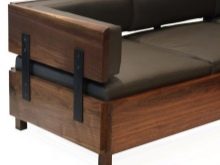

But the most solid blanks used for the production of furniture are made from:
- maple;
- merbau;
- exotic breeds.
It should be borne in mind that high mechanical strength is not everything. So, a strong beech suffers greatly from moisture. On the other hand, for a relatively soft teak, it is practically safe.
Thermowood is becoming more and more widespread. It endures both contact with water and significant loads.



Plywood, oddly enough, is more expensive and Chipboard, and even wood. However, this material is lightweight and particularly reliable. Under normal conditions, quality plywood will not deform. There is only one minus: it is impossible to glue it. Therefore, large sofas with a plywood frame are not even made to order; use either chipboard, or MDF, or an array.
MDF practically does not warp. This is a fairly durable material that does not dry out. It is resistant to moisture ingress. Furniture made of MDF will suit even those suffering from chronic allergies. But systematic or very long contact with water must be avoided, if only because it leads to swelling.


Soft filler plays an equally important role.
Foamed polyurethane foam can last a long time and is environmentally friendly. Due to its rigidity, PU foam is stable. It will quickly regain its shape even after exposure to significant stress.
But also traditional foam rubber should not be discounted. The latest versions of this material fully comply with current standards. There are both hard and lightweight types of foam rubber. Sometimes it is even molded.
Constructions with holofiber... Due to the unique microscopic structure (spatial spiral), this material perfectly retains its shape and quickly restores it as needed.


And also sofas can stuff:
- padding polyester;
- durafil;
- skyron.



Styles
The conversation about the style of sofas is special, not the same as in general in relation to the interior or even to other furniture. There are specific styles that are not used anywhere else.
Most of the styles were created by English or French designers. The thing is that these countries have been the trendsetters in furniture fashion for centuries.



English style always implies the use of rounded armrests. This solution looks appropriate not only in an English, but also in a neoclassical room. But if you have chosen an impeccable classic in the interior, you need to pay attention to other solutions. English sofas are mostly covered with plain upholstery.
If the room is closer to a modern style, you can use brighter colors.

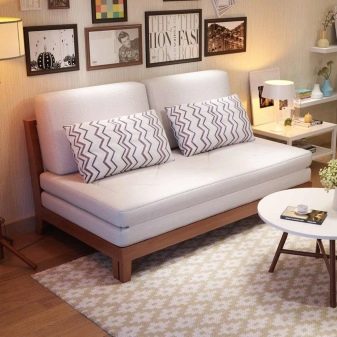
Convertibles in shape, they just resemble the body of a car of the same name. They are often used in a postmodern setting, in fusion and lounge styles. Suitable for use in other glamorous interiors. Users will have to choose between a simple monochromatic color and the use of large ornaments, catchy designs.
It is categorically impossible to combine such solutions.


In some semi-antique rooms, sofas are appropriate chesterfield style... Both the back and the armrests are rounded.The legs are made strictly of wood, and not only are not masked - they turn into an expressive external element.


Sheathing allowed:
- velvet;
- natural skin;
- flock;
- velor;
- skin substitute.

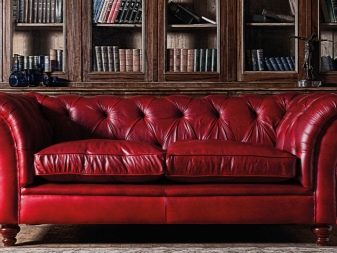


Camelback speaks for itself: its back is like the back of a camel. Usually such furniture is covered with velvet, velor or flock upholstery. It will look good in medium-sized city apartments with an aristocratic direction in the interior. Camelbacks in the Scandinavian style are appropriate when reproducing the spirit of the 1960s.
In principle, they are not suitable for suburban housing.
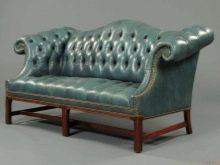


In the USA and Europe, it is very popular lawson... Despite the active changes being made by developers and designers at each firm, it is easily recognizable. Such sofas fit harmoniously not only in American, but also in minimalist and Asian interiors.
If the room is furnished in the spirit of Scandinavia, the most logical source of fresh ideas will be the assortment of the IKEA store. Sometimes, however, you just need to buy a finished product there and not suffer from the agony of searching.


Chinese style sofas outwardly laconic and simple. It's amazing how they manage to keep such a delicate balance of functionality and sophistication.
Specific traits:
- low height;
- mostly lack of legs;
- hard fillers;
- plain color of the upholstery.



And also you can think of other styles:
- provence;
- nautical;
- American;
- empire

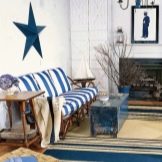


How to choose?
For a terrace, where the whole family and even guests often gather, it is worth giving preference to large corner furniture. An alternative is a fixed sofa with pillows, a high back and a wide seat. If you need to furnish the house, you can opt for folding models with the most common transformation mechanisms.
If funds are available, it is better to focus on versions with particularly rigid fillers or independent spring blocks.
It is these solutions that have proven themselves from the best side.


Picking up sofa in the bathas well as in the kitchen, special attention should be paid to models with waterproof upholstery. Ease of maintenance is equally important. The more natural the upholstery, the better and safer. It is very good if a hydrophobic impregnation is used.
Leatherette cannot be used as upholstery for bathroom furniture.

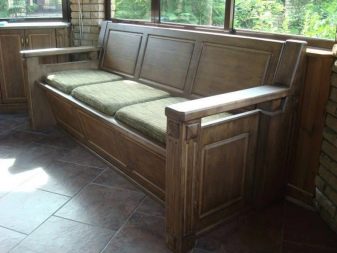
When to choose sofa in a country-style room (and its branches of Provence), it is necessary to refuse models with upholstery. They are decorated with pillows or special blocks. Open wood looks impressive and pleasant. It is advisable to use oak, walnut, cherry massif. Sometimes mahogany is also used.


Country sofas in the spirit of country, painted brighter than those intended for the city. They actively use fringe and ruffles, small pads. If you don't like monochromatic solutions, you can use checkered and floral motifs. It is necessary to figure out what is the permissible surface load.
The more people use the sofa, the higher this figure should be.


A good frame is one that does not creak or wobble. No sounds should be heard during landing. And you should also pay attention to:
- manufacturer's reputation;
- reviews;
- upholstery quality;
- clarity of the picture;
- build quality.


Beautiful examples
A sleek, traditional sofa. Moreover, the carved elements accentuate the retro spirit as clearly as possible. The prevailing dark colors are well balanced. The pillows don't make a bad impression. In general, the interior is also built on the basis of wood colors.

A discreet light brown straight sofa looks very good. An optimal balance is ensured between its color and the color of the pillows and upholstery. Clear and straight lines are perceived gracefully. Compatibility with classic components (paintings, lamps and plants) is close to ideal. The combination of a sofa with a carpet deserves approval.

In the next video, see an overview of a classic-style wooden sofa.








